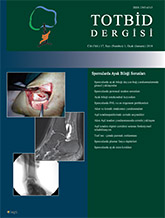
Peroneal tendon injuries are common, and the frequency of diagnosis is gradually increasing especially in athletes. Peroneal tendon injuries are commonly misdiagnosed as lateral ankle sprain, and treated wrongly. A pathology that could be treated easily in acute period would need surgery in chronic period because of this wrong treatment.
Peroneal tendon injuries should be suspected and related investigations should be done in patients have persistent lateral ankle pain after ankle sprain history. Even if most of the patients get diagnosis in the chronic period, it is very important to keep in mind that acute tear of peroneus brevis and the less common peroneus longus tear should not be ignored.
Pathologies like peroneal subluxation and peroneal dislocation that are associated with peroneal tendon injuries are the other peroneal tendon pathologies which could be seen in both acute and chronic periods. Peroneal tendon dislocations usually occur after sports injuries, especially after skiing. Also, it usually occurs after ice skating, football, basketball, rugby, and gymnastics.
Conservative treatment of peroneus longus and brevis are similar. Rest, immobilization, cryotherapy and nonsteroidal anti-inflammatory drugs are effective treatments in acute period of injury. But conservative treatment is successful at 20% of cases and the rest (80%) will need surgical treatment. Short leg cast that keeps foot in plantar flexion and inversion to reduce peroneals should be performed for 6 weeks for conservative treatment of subluxation and dislocation. In surgical treatment; directly repair of superior peroneal retinaculum (SPR), reconstruction of SPR, tendon re-routing, bone block, and groove deepening procedures can be used.